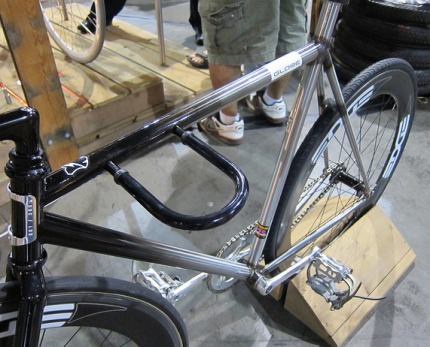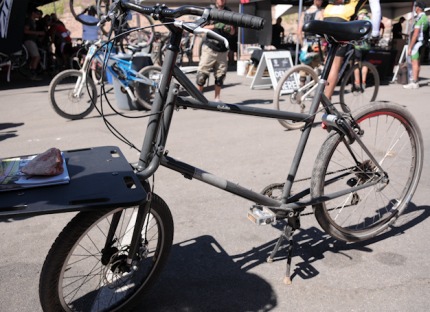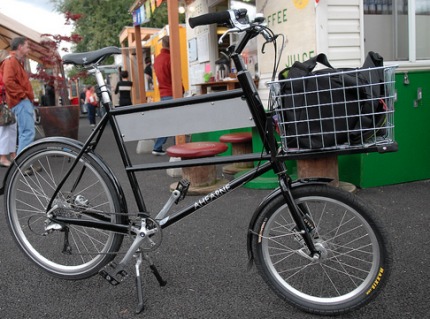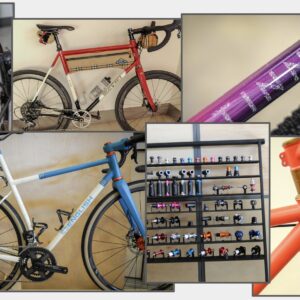Two new bike models shown at the Interbike trade show in Las Vegas last week borrow major design elements from Portland-based custom bike builders. As we noted with Electra’s Ticino line, being inspired by small builders is nothing new, but I feel the two examples below warrant more attention.
The first example is from Globe, a brand owned and developed by industry juggernaut Specialized Bicycles Inc. I unfortunately missed this bike while at the show, but came across an image of it on Flickr. The bike (see photo below) is an urban fixed-gear with deep-dish carbon rims and a riser bar that has one very familiar feature — a u-lock integrated into the top tube…

(Photo by Ricky deLeyos/Flickr)
The integrated u-lock looks like it was inspired by a design first dreamed up last October by Tony Pereira of Pereira Cycles. Tony integrated a u-lock into his winning entry into the Constructor’s Design Challenge of the Oregon Manifest event last October. Here’s Tony’s version (which, unlike the Globe, also locks the steering) …

The Globe bike was designed by Garrett Chow, a notable figure in the urban fixed gear scene as a member of MASH SF and who now does brand management and creative direction for Globe’s “Roll” line. I asked Chow this morning about his inspiration for the u-lock feature. He said he hadn’t even seen the Pereira bike until someone pointed it out to him yesterday. Chow said he thought Pereira’s idea was “really cool,” but it wasn’t part of his inspiration. “It was just something I thought of… I’m always trying to figure out ways to do things quickly.” Chow added that he put the u-lock on the top tube so riders could quickly lock to parking meters.
Pereira said he felt a little bit “ripped off” after seeing the Globe Bike. “To see Specialized come out with one at Interbike, 11 months later, is sort of flattering, but also a bit disappointing,” he told me on the phone yesterday, “I feel a little bit ripped off.”
Interestingly, back in October I asked noted bike designer Sky Yaeger (one of the judges of the Constructor’s Design Challenge event where Pereira’s bike debuted) whether or not the entries would impact bike design industry-wide. Here’s the answer she gave:
“Yes, because the big guys are never first to market with anything cool, so they will be looking at these bikes and we’ll see everything from blatant rip-offs to barely disguised rip-offs of them in their respective lines next year.”
[Bryant Bainbridge, who works in product creation for Specialized Bicycles was also a judge at the Oregon Manifest event.]
Read more responses to the Globe Bike from Pereira and others on bundobiker’s Flickr photo page.
The next example comes from Civia, a bike brand owned and developed by Quality Bicycle Products. Civia’s new Halsted cargo bike is based on the tried and true cycle-truck design where a large front rack is attached to the frame instead of the forks (which makes for a sturdier rack and allows the front wheel to turn independently of the load). Here’s the Halsted at the Outdoor Demo…

(Photo © J. Maus)
The cycle truck concept has been around for decades, but was brought back into the limelight earlier this year by Portland builder Joseph Ahearne of Ahearne Cycles. Ahearne unveiled his Cycle Truck at the Pedal Nation Bike Show back in April.

(Photo © J. Maus)
When speaking to Civia brand manager Scott Thayer about the Halsted at Interbike, he didn’t hide the fact that he was inspired by Ahearne’s design. Thayer said Civia is making the cycle truck more accessible to the masses by offering it for a fraction of the price of the Ahearne model — about $1,000 retail for the Civia versus about $2,700 for an Ahearne.
I stopped by Ahearne’s shop yesterday to find out what he thinks about the Halsted. “When I first saw it I was kind of frustrated,” he said, “But the more I think about it, if anything, it will raise awareness about this type of bike in general.” Ahearne thinks having a larger company educate the bike-buying public about cycle trucks could actually help his sales (sort of like how Starbucks made good coffee popular and spurred success of smaller roasters). But, Ahearne adds, this phenomenon of being copied by larger companies has a point of diminishing returns. “If Trek and Specialized start making a cycle truck, I’m screwed.”
UPDATE, 11:54 a.m.: Just out of curiousity, I asked local intellectual property attorney Shawn Kolitch of Kolisch Hartwell, P.C. what he thought about this. Here’s what he said (edited for brevity):
“Pereira’s integrated u-lock and Ahearne’s integrated front rack are potentially protectable by intellectual property law, if they were new to the bike industry when Pereira and Ahearne introduced them…
In the U.S., inventors are given a one-year grace period to file a patent application after first publicly disclosing the invention. Therefore, if Tony’s first public disclosure of the integrated u-lock was last October, he could still apply for a U.S. patent now. Similarly, if Ahearne introduced his cycle truck earlier this year, he could still apply for a U.S. patent on any aspects of his design that were new. One year after public disclosure, U.S. patent rights are lost and the invention becomes part of the public domain.”






Thanks for reading.
BikePortland has served this community with independent community journalism since 2005. We rely on subscriptions from readers like you to survive. Your financial support is vital in keeping this valuable resource alive and well.
Please subscribe today to strengthen and expand our work.
Copying and proliferating good ideas progresses the human race. It’s very cool that Portlanders are leading the way.
It’s certainly hard to distinguish ripoff from flattery. I’d like to hear some viewpoints from smaller builders on this. Are innovative features a testament to what the builders skill can achieve, or are they intellectual property to be sold and mass produced?
That’s how trends work in any consumer goods industry.
I bought an Ahearne this summer, and I knew at once (as you can see in this picture: http://fb.me/HQJNvKF8 ) that it wasn’t an original design. Judging from the pictures that Civia has posted, the Ahearne is at a completely different level of quality and craftsmanship.
Just to use the U-lock as an example, the Ahearne’s tray stays fit a U-lock perfectly between them; the Civia doesn’t have that feature and you’d have to either mount an ugly bracket or carry the lock as cargo.
If Trek or Specialized makes a cargo truck, it’s Civia that’s screwed, not Ahearne.
i think ANT had a couple cycle truck(ish) designs before Ahearne, right?
http://www.antbikemike.com/bikes.html
seems like a silly thing to get frustrated over, since it wasn’t an original concept to begin with.
If you’re not going to patent your ideas, and you show your stuff in public – it’s fair game. It sucks, but if you’re in the design business and you don’t patent, then you’re setting yourself up to get ripped off.
With something as geometrically simple as a bicycle, it’s pretty easy for two people to arrive at the same design independently.
I bet the first guy to invent the diamond frame has rolled over in his grave a million times by now.
time to lawyer up and sue the bastards!
That Specialized bike with integrated u-lock would really hurt my left knee…. because I’d be whacking it on the u-lock on every up-stroke!
I like Tony’s design better, I don’t think I’d have as many bruises.
You can’t patent something with that much prior art, check that with our ridiculous patent system you probably could patent something with that much prior art, but you shouldn’t.
I see this as complimentary of Portland’s bike builder community. However it is also a reminder that I need to budget my expenses to support my local community properly and avoid the Walmartization of the bike market.
It is depressing to see good ideas exploited by big companies using mass production and exploitative cheap labor but I don’t see much legal recourse here. The only way to fight this is buy locally and encourage/educate others to do the same.
“Yes, because the big guys are never first to market with anything cool, so they will be looking at these bikes and we’ll see everything from blatant rip-offs to barely disguised rip-offs of them in their respective lines next year.”
So the big guys should just stop spending millions of dollars a year on RnD?..right.
Don’t both of those integrated U-lock designs put the lock too high off the ground to work on a lot of racks?
The problem with comparing Portland’s bike builders with the big names is that there seems to be little middle ground. Either you buy something locally hand-crafted by a master artisan at an absurd price, or you buy something mass-produced in an Asian factory.
I like to buy local, but I don’t want a luxury item, or its accompanying price tag. So I’m much more likely to buy the Civia than the Ahearne. I understand that local builders are probably forced into focusing on the high-end niche due in order to make a living, but it leaves people like me between a rock and a hard place.
Regarding the patent issue: The cycle truck is clearly a very old idea. Pereira’s lock seems to be more original, so maybe he could patent it. However, I don’t see this as something to be happy about. It would award him a temporary monopoly on the idea, helping his business, but stifling proliferation of the idea, which is bad for society as a whole. Getting angry at Specialized or whoever is missing the point that lots of people would benefit from those bikes made by Specialized.
Nick. thanks for the comment. A few things…
The problem with America is that too many people think actual, real prices for goods are “absurd.” What’s really absurd – for what’s doing to our planet, our economy, and the quality of products themselves – is the artificial cheapness we’ve come to expect from consumer goods. i’m not saying made in china is evil..i’m just saying “absurd” and “luxury item” is in the eye of the beholder.
Cycle trucks have been around for years. See the Schwinn cycle truck from 1955.
http://i31.tinypic.com/xndift.jpg
http://www.cyclofiend.com/working/images08/wb107-1R0013541.jpg
http://www.bunchobikes.com/1955Cycletruck.htm
As seen on BSNYC/RTMS yesterday.
I’m finding the discussion here interesting. Thanks for the support!
For what it’s worth, I’ve researched getting a patent and I doubt it’s worth my time or money. On top of that, the Globe bike wouldn’t violate the idea I’m interested in patenting, which is an integrated lock that also locks the steering to make the bike more stable for loading and unloading cargo. Without the steering lock it’s just another lock that is built into a bike and that’s been done many times before.
My original idea was designed around the “staple” racks that we see everywhere in Portland. My newest version also easily fits around any vertical pole up to 3″ in diameter. I also carry a cable that can be used with the integrated lock to secure the wheels and lock to an object that isn’t compatible with the shackle position.
Come see it at the OBCA bike show October 9th and 10th:
http://oregonhandmadebicycleshow.com/
With regard to hitting your knee on either design while riding: The shackle is not meant to be in place when riding the bike.
As far as sharing ideas goes, I don’t have much to stand on. All my bikes borrow from previous designs. There isn’t a whole lot new going on in bike design–especially steel bikes. I’m a bit of a bike history buff and frequently reference old designs for inspiration. My goal is to build the best bike for my customer’s needs. I have a style that is my own and am very happy that people respond to it so passionately.
I’m very lucky to be able to do what I do. Thanks everyone!
Mr. Pereira, classy as ever. Thanks for weighing in. And thanks for working so hard to put Portland ahead of the curve in quality artisan/craft bike design. You and your peers make every outing in town a bit more fun via the prospect of seeing your handiwork rolling around turning heads. Everything old is new again!
You rock, Tony! Nice guys will inherit the earth.
On Ahearne’s Cycle Truck and the Civia Halsted, I’ve ridden both, and also talked to Civia about inspiration. I got a different story, namely that Civia began work on the project before becoming aware of Joseph’s work, but that seeing Joseph go successfully to market did have an influence on timeline and (my inference here, not something I was told) differentiating features besides price. As others have noted, the concept is nothing new. Can you say validation?
I think the 2 bikes appeal to different enough rider classes as not to represent simple cannibalism. Overlap, yeah, some.
Ahearne’s bike is built beautifully, in Oregon, as the huge cost difference should lead you to expect. It’s functional art. Halsted shows fine Taiwanese workmanship like any number of other fine Taiwan-built frames, but it doesn’t rise to the level of investment-class artisanal craft. (Sorry, Wu Ming, we know you’re an artist too, but those bastards won’t pay you enough to let you take the extra time. It’s not like your name is going to be on it anyway.) Ahearne’s looks a lot sharper to my eye, too, more classical.
Both ride really well, but not the same. I didn’t have enough time on both, and too much time between, to compare handling in detail, but the Ahearne felt sportier overall. I would expect to be able to ride the Ahearne at a higher intensity level, longer and more comfortably, than the Halsted. Both felt stiff loaded (adult passenger on the front), but the Ahearne felt stiffest.
The Halsted has a much more relaxed seat tube angle (68), transferring weight off hands and making a more gentle pace feel right (please don’t call it a cruiser). This also means it’s easier to get a stabilizing foot down at stops on the Halsted without leaning the bike. Because the head angle is much steeper than the seat, raising and lowering the saddle results in more significant changes to the cockpit length, making it more nearly one-size-fits-most than Ahearne’s design. And the deeply sloped top tube permits a wider range of saddle height adjustment. Low top tube also means step-through mount and dismount (instead of swing-over-rear-and-try-not-to-kick-child-in-head): yeah, the Halsted will be better for a child seat. Together, I think these features will make the Halsted a smart choice as a family utility vehicle, shared by parents of different heights.
The Ahearne will appeal more to people demanding the familiar ride qualities of their fine “regular” bikes, and who are willing and able to support beautiful Oregon artisanal bike design and fabrication, semi-custom, made to order, pick-your-color etc.
About lock carriage: the Halsted has seat stay braze-ons for a European-standard ring lock (seen in the photo above), which frankly I find more elegant than any U-lock portage scheme. It also has semi-horizontal dropouts for ready compatibility with an internal gear hub, while Ahearne’s vertical dropouts mean you want/need an eccentric bottom bracket version frame at extra cost for clean chain tension management.
The original “Stumpjumper” was a blantant rip-off of Ritchey & Cunningham’s Mtn bike designs.
If anyone’s looking for representation, we use Chris Tuttle at AHMRT to protect everything from product designs to the copy on our website. He’s bike people.
The cycle truck is light years from original.
Tony’s U-Lock is close to original. But I own my dad’s 1953 Schwinn Phantom with a lock in the steering column. It makes the bike even more stable than Tony’s because it locks with the bars at an angle. It also has an integrated headlight, a design most likely “stolen” from a horse drawn carriage.
Tony. Thanks for the honesty “I’m a bit of a bike history buff and frequently reference old designs for inspiration.”
This has been a great look into how the public perceives intellectual property in the bike world.
I built a lock very similar to Tony Pereira’s on a single-speed frame, based on a Kryptonite lock, during the summer of 2009. I briefly considered patenting it, but then saw that Tony had built a very similar idea. Here are some thoughts on the process:
Patenting the thing would technically be legal for me to do up until about this September. But the independent bike industry is so small that holding onto ideas is less fruitful than sharing them. Mostly it protects your IP from getting poached by a large company. If the lock concept turns out to be profitable, then there is a lot at stake for everyone involved, and the patent process creates a solid legal framework for arbitrating disputes. The patent system is there to protect the small guys, even though (as with all law) money buys you advantages but not absolute advantages.
The idea for an in-frame bike lock is one of the few ideas that hasn’t already been around for eighty years. A lot of similar variants exist, but not for this arrangement of in-frame lock and floating U-bar.
I finally decided not to patent it, partly because I don’t see a lot of real value in the idea. I predict commercial stagnation for the Specialized bike in a few years, for the following reasons, most of which I accumulated by riding my own bike around town:
1. The U-bar is annoying to carry. You either need a special bracket on your bike to carry the U, or stuff it in your pants fixie-style. An on-bike bracket fouls up the clean lines of a single speed bike. You save the weight of the steel tube over the shackle, but don’t gain any usability.
2. You can’t use the lock on another bike, or lend it to a friend.
3. If you lose the key or U-bar, you are dependent on Specialized having a key replacement program. I doubt that Specialized uses standard Krypto or OnGuard lock cores, so the option of replacing it on your own isn’t there. (How many times have you or friends had to discard locks because you lost the key?) This creates a proprietary system in which Specialized is your only source for repairing your lock. Not even your LBS can help you.
4. It’s a pain to lock to an angled bar. Uprights work fine, but you have the weight of the bike working against you if you have to lever it into a flying position to lock it up.
If buyers can get past these hurdles, perhaps this concept will be accepted on more bikes. If it’s true that the creator of the Globe bike didn’t see Tony’s bike in Portland or my bike around Berkeley/SF, then it’s truly a work of independent creation. Best of luck to them if that’s the case.
Finally, here’s my bike on Flickr:
http://www.flickr.com/photos/15024114@N00/4110213489/in/set-72157622694366433/
You folks take yourselves too seriously.
As may have said, the “Truck bike” is hardly new, and you can buy a Made in America truck bike from Worksman Cycles for less than $600 – They have been making the Low Gravity for decades. I am glad that there is a market for very nice, handbuilt utility bikes like Ahearn’s , but I hardly think that there are grounds for any patents to be filed. That said, I do think that Tony’s design is way better than the Globe.
Jonathan wrote: “What’s really absurd – for what’s doing to our planet, our economy, and the quality of products themselves – is the artificial cheapness we’ve come to expect from consumer goods.”
*****
Indeed. Unfortunately, we’ve been expecting — and demanding — cheap stuff for a very long time; and I predict that this won’t change until it becomes much harder to import things from overseas for so little money.
Stop subsidizing petroleum (or just run out of the stuff, take your pick), make it harder to ship rubber and metal around the globe, and voila! We’ll all be compelled to reconsider the TRUE value of a revitalized, LOCAL manufacturing sector.
The problem lies less in copying cool ideas from small independents than it does in where the industry focuses its trickle-down resources AFTER development. I saw way too much cheap carbon fiber (as in cheap copies of racing designs) at Interbike and too little in the way of affordable, well-made steel commuter bikes). This could be taken as a sign that things are already changing.
I wouldn’t worry too much about Tony Pereira or Joseph Ahearne. Not only is their creativity and craftsmanship in demand, but their ingenuity is fueled in part by a great sense of resourcefulness — and that’s a quality we will all need more of as the economies of scale continue to evolve. Bravo to both of them.
Jonathan,
Did you have a chance to ask any of these designers if a patent was filed or if there are plans to?
Seems to me the best bet is to file for a patent before revealing your design to the public, unless your goal is to not protect it. Worst case, big company patents the idea and has the lawyers to defend it and you can’t prove prior art. Filing the patent is the easier part, defending it is where the bigger costs come in from what I understand. My friends have filed patents for under a grand, and advertise their products with “patent pending” to document that. After conducting a patent search, that is, which is frankly a pain the a…
Ryan @16
Love those pictures!
Tony, thanks for speaking up candidly. As I read this I couldn’t help but wonder how many custom builders ‘borrow’ geometry/features from bikes made by bigger companies. Please correct me if I’m wrong here…
I have a ton of respect for local craftsmen. And also agree with Maus about the artficially low cost of mass production (and do wish he’d fess up if he found this through Bike Snob’s site, if that was his source, given that this story is about the origin of ideas…
Tony, thanks for speaking up candidly. As I read this I couldn’t help but wonder how many custom builders ‘borrow’ geometry/features from bikes made by bigger companies. Please correct me if I’m wrong here…
I have a ton of respect for local craftsmen. And also agree with Maus about the artficially low cost of mass production (and do wish he’d fess up if he found this through Bike Snob’s site, if that was his source, given that this story is about the origin of ideas…
Pashley has been making the Delibike for years too – http://www.pashley.co.uk/products/delibike.html
Imitation is the sincerest form of flatery – right?
Thanks everyone for the comments. I wanted to respond to a few of them.
– As I mentioned in the article, I am well aware the cycle truck has been around forever. This story simply points out that Civia would most likely not have come out with the Halsted if not for seeing Ahearne bring it out of the shadows and make it cool.
– As for Bikesnob. Two things. This article is NOT about “the origin of ideas.” I simply point out that some designs we’ve seen from portland builders are now seen on bikes from national brands. Also, I have not seen the bikesnob mention of this. I first saw the Globe bike via a Tweet from Tony Pereira that linked to the Flickr photo I’ve used in the story (with permission).
Again, I am not trying to accuse anyone of stealing ideas. I am simply showing what is out there and trying to satisfy the curiousity of people (hence the word about patents from the attorney). thanks.
“There are no original ideas. There are only original people.”
Barbara Grizzuti Harrison
Jonathan. I completely disagree with you on the cycle truck. These are heavy duty built bikes with intended purposes. They were never in the shadows if you used one and were always cool to those who used them as intended. Seriously though. Cargo bikes aren’t meant to look cool. Form vs function is an old argument, but putting lipstick on a pig just because you can is silly. Pig’s just gonna roll in the mud anyway.
Also i think it’s important to credit the skill of overseas bike builders. Taiwanese welders are some of the best there are. Maybe if some of the local brazing bicycle builders took the time to learn to TIG weld they could build bicycle at a competitive rate and not need to focus on design so much.
Thanks to the people that picked up on the Halsted at Interbike. We began working on this project in the middle of 2009 and the bike we showed at Interbike was our second prototype. Around the time we received our first prototype was when Ahearne launched his model. The quote attributed to me saying we wouldn’t have done the bike without seeing the Ahearne isn’t accurate. Cycle trucks have been around forever, we wanted to improve on the concept and make it available to more people.
Civia is about bicycles as transportation. We see the cycle truck as another opportunity to bring style, substance and attainability to the category.
As others have stated, most ideas are improvements on earlier concepts. Schwinn has their truck from decades ago. Europeans have their postal delivery bikes. Henry Work Cycles has their Fr8, Monark has their Truck, Sycip and Ahearne have their trucks. Now we’re adding ours. Trek and Specialized? They might, but I doubt the volume is there to warrant their foray into the category.
Scott,
Thanks for your comment. I just want to make something clear. You wrote:
There is no such quote like that attributed to you. Please re-read the article.
The article says you were inspired by Ahearne’s Cycle Truck. The article includes no quote from you.
My comment #33 should have been more clear in stating that it’s my opinion that the Halsted would not have come out if not for Ahearne. But again, nowhere on this page have I attributed that quote to you.
Thanks and as I said to you at Interbike, I’m excited to see how Civia has grown and I’m loving all the stuff you guys are doing.
cheers.
Thanks everyone for putting in your thoughts on this.
As Tony said, bike builders are working mostly from borrowed ideas, and if you think you’ve come up with something new and unique, look around and you’ll probably see that it’s already been done. But, that’s one of the great things about it — looking at how you can use older ideas in new ways.
I’ve looked into getting patents as well. I thought about it for the flask holder. But the cost of patents is so high that you’ve really got to have something special to make it worth the time and money. It’s very expensive getting a patent, and in many cases, just not worth it.
I’m glad to hear from Scott Thayer about the Halsted. Because of the lead time on production overseas I figured Civia must have been working on this project for a long time. My initial feeling of frustration was more to do with the fact that my version of the Cycle Truck was very new, and I wanted to make sure it had enough opportunity to get out there before the next New Thing arrived on the scene.
But, it didn’t take long for me to realize that my frustration was misplaced, and that really, the one thing I lack in the equation of getting the word out about my Cycle Truck is a marketing budget. Because it’s an unconventional bike, people need to be exposed to them to understand what they are about, and what they’re good for. Now, because of the Halsted, there is going to be more awareness about this type of bike, and every time someone does a google search for a cycle truck, there I’ll be.
Costs and environmental ethics in regards to manufacturing domestically vs. overseas is a huge subject. American manufacturing mostly can’t compete with overseas costs. We as consumers have to weigh what’s important to us, and what is financially viable. Unfortunately, not everyone has the option of buying locally made products because of the higher price. I get that.
For Cycle Truck production I chose to work with Co-Motion Cycles in Eugene, Oregon because they are 1) awesome and 2) local. They TIG weld and I don’t. The cost of Cycle Trucks would be twice as much if I built them because I’m not set up to do production at that level. I build one at a time.
In regards to the my Cycle Truck being a “luxury item,” I agree with Jonathan, that this is in the eye of the beholder. I didn’t build them to be cool or artisan or beautiful. I built them to be functional. I designed it to do certain things and to accommodate certain types of components. There is nothing superfluous on the bike. Except maybe the nice paint. In designing the bike, once everything is there that needs to be there, I then try and make it all fit together aesthetically. But really, aesthetics is an afterthought.